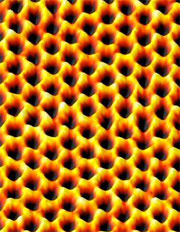Engineers and scientists at The University of Texas at Austin have achieved a breakthrough in the use of a one-atom thick structure called "graphene" as a new carbon-based material for storing electrical charge in ultracapacitor devices, perhaps paving the way for the massive installation of renewable energies such as wind and solar power.
The researchers believe their breakthrough shows promise that graphene (a form of carbon) could eventually double the capacity of existing ultracapacitors, which are manufactured using an entirely different form of carbon.
"Through such a device, electrical charge can be rapidly stored on the graphene sheets, and released from them as well for the delivery of electrical current and, thus, electrical power," says Rod Ruoff, a mechanical engineering professor and a physical chemist. "There are reasons to think that the ability to store electrical charge can be about double that of current commercially used materials. We are working to see if that prediction will be borne out in the laboratory."
Two main methods exist to store electrical energy: in rechargeable batteries and in ultracapacitors which are becoming increasingly commercialized but are not yet as popularly known. An ultracapacitor can be used in a wide range of energy capture and storage applications and are used either by themselves as the primary power source or in combination with batteries or fuel cells. Some advantages of ultracapacitors over more traditional energy storage devices (such as batteries) include: higher power capability, longer life, a wider thermal operating range, lighter, more flexible packaging and lower maintenance, Ruoff says.
Ruoff and his team prepared chemically modified graphene material and, using several types of common electrolytes, have constructed and electrically tested graphene-based ultracapacitor cells. The amount of electrical charge stored per weight (called "specific capacitance") of the graphene material has already rivaled the values available in existing ultracapacitors, and modeling suggests the possibility of doubling the capacity.
"Our interest derives from the exceptional properties of these atom-thick and electrically conductive graphene sheets, because in principle all of the surface of this new carbon material can be in contact with the electrolyte," says Ruoff, who holds the Cockrell Family Regents Chair in Engineering #7. "Graphene's surface area of 2630 m2/gram (almost the area of a football field in about 1/500th of a pound of material) means that a greater number of positive or negative ions in the electrolyte can form a layer on the graphene sheets resulting in exceptional levels of stored charge."
The U.S. Department of Energy has said that an improved method for storage of electrical energy is one of the main challenges preventing the substantial installation of renewable energies such as wind and solar power. Storage is vital for times when the wind doesn't blow or the sun doesn't shine. During those times, the stored electrical energy can be delivered through the electrical grid as needed.
Ruoff's team includes graduate student Meryl Stoller and postdoctoral fellows Sungjin Park, Yanwu Zhu and Jinho An, all from the Mechanical Engineering Department and the Texas Materials Institute at the university. Their findings will be published in the Oct. 8 edition of Nano Letters. The article was posted on the journal's Web site this week.
This technology, Stoller says, has the promise of significantly improving the efficiency and performance of electric and hybrid cars, buses, trains and trams. Even everyday devices such as office copiers and cell phones benefit from the improved power delivery and long lifetimes of ultracapacitors.
Ruoff says significant implementation of wind farms for generation of electricity is occurring throughout the world and the United States, with Texas and California first and second in the generation of wind power.
According to the American Wind Energy Association, in 2007 wind power installation grew 45 percent in this country. Ruoff says if the energy production from wind turbine technology grew at 45 percent annually for the next 20 years, the total energy production (from wind alone) would almost equal the entire energy production of the world from all sources in 2007.
"While it is unlikely that such explosive installation and use of wind can continue at this growth rate for 20 years, one can see the possibilities, and also ponder the issues of scale," he says. "Electrical energy storage becomes a critical component when very large quantities of renewable electrical energy are being generated."
Funding and support was provided by the Texas Nanotechnology Research Superiority Initiative, The University of Texas at Austin and a Korea Research Foundation Grant for fellowship support for Dr. Park.

